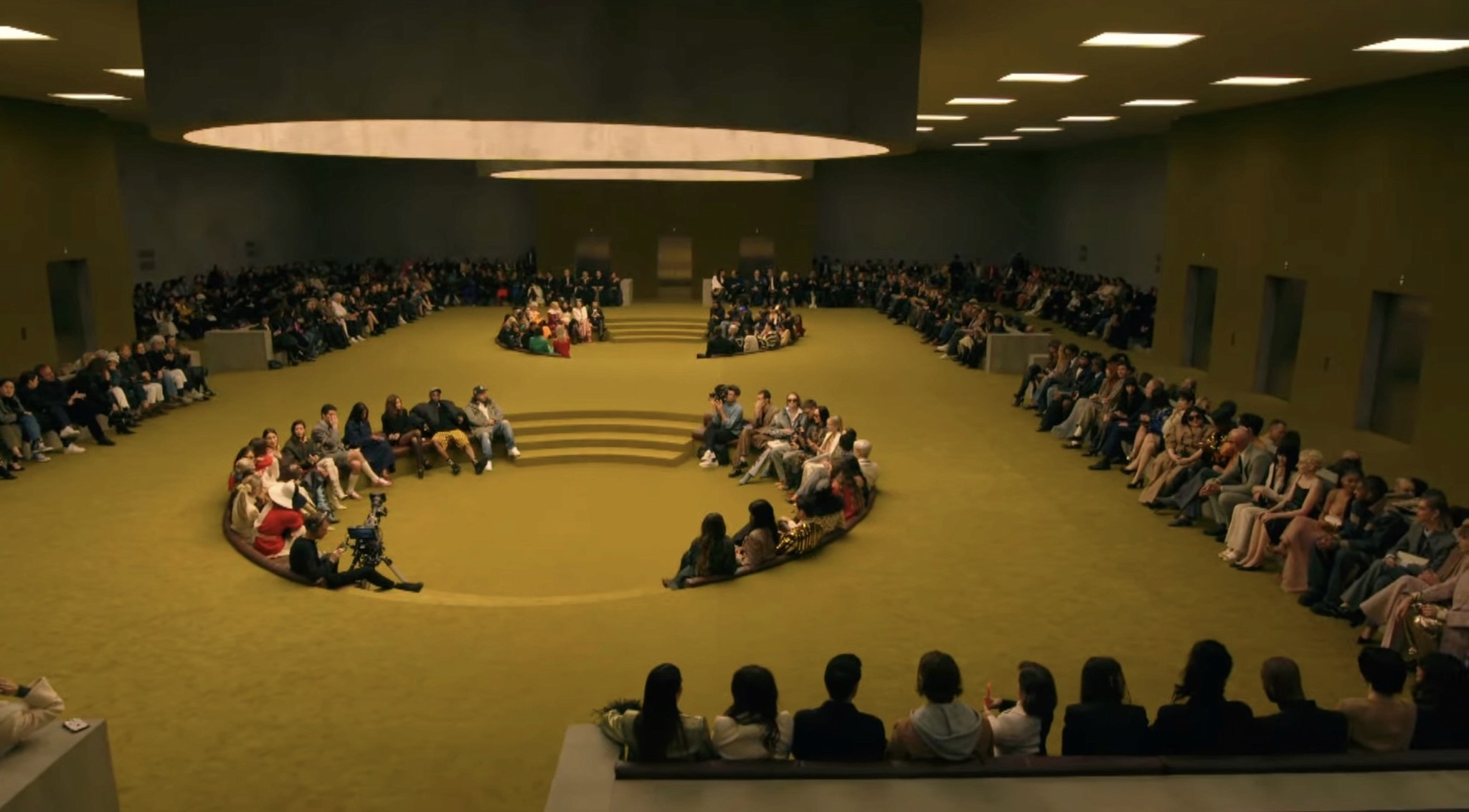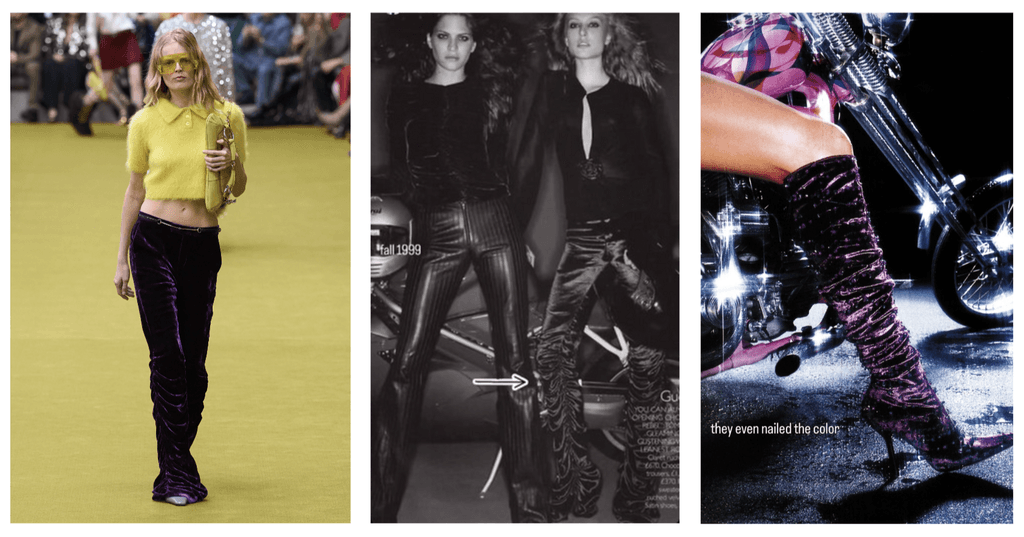February 26, 2023
February 26, 2023
FW23
Gucci presented its fall / winter 2023 collection last Friday in Milan. Though the collection was somewhat jumbled, it was a clear homage to past, present, future identity of the brand — a timely theme given Alessandro Michele's recent departure and the appointment of Sabato de Sarno as new creative director, who will debut his first collection in 2024 (Gucci's creative team took lead on this season in the interim). Revered symbols of past Gucci eras permeated the collection — Tom Ford's sleek tailoring of the late 90's / early 2000's, Michele's wilder more eccentric pairings that evoke an uncanny valley spirit with bright furs, intricate embellishments. We were expecting a tribute to the Gucci archive, though I don't think anyone predicted such a literal representation of past collections. A nod to the house's heritage, however, is one that I think was not overdone.
Legacy identity is a theme present currently at many of the luxury brands, perhaps most perfectly executed at Bottega Veneta with Matthieu Blazy at the helm. His debut collection last year made waves with a genius reversion to the true spirit of the House — Bottega Veneta is pragmatic, because in essence, it is a leather goods company. Thus, his first collections play a trick on the eye with material — what appears visually to be one thing (denim, wool) is indeed all another (leather). Last season, Kate Moss walked the runway in a look which went viral — a white tank, flannel and jeans concept which upon closer look was entirely made of (again) leather. He actually pushed the theme to a higher extent this season at yesterday's show. Nothing is as it appears, like the supposedly knitted red wool socks below (the entire look is actually leather). He simultaneously holds the brand's heritage intreccio weave constant in select new iterations of knee boots and Sardine bags, an effective balance (and contrast) of tradition and modernity. Blazy brings a fresh sensibility to Bottega's heritage by transposing fabrics and messing with our instincts.
Outside of fashion, a focus on fundamentals has been the clear point of emphasis for investors and founders in the tech ecosystem since the second half of last year. The primary points in this context are metrics and milestones – revenue, burn rate, timeline to profitability. While these are important elements to pay attention to, equally as important is “getting back to basics” in a product / feature / value proposition sense. What is the singular feature that makes a product exceptional? What is the true core of a business, and what does it look like to lean into this proposition fully? What does it mean to remove all excess and focus on a product / problem in its most raw form? This feels particularly important in a competitive ecosystem that is beginning to crack in a tightening economy. Where it feels like there is room to experiment is in the ability to play with what a feature or proposition looks like or means in an updated format – how can you deliver the same value or the same felt sense in a modern way? Apple, though an obvious example, does this incredibly well.
Abundant access to capital over the last several years has enabled a cross-disciplinarianism to occur with companies expanding into areas they may not necessarily belong. Though not a perfect example, the extent to which every company has attempted to become a web3 company feels excessive. There is a baseline level of innovation / experimentation required to stay at the forefront in a fast-moving world, yet the difficulty lies in preserving the true structural identity of a business simultaneously. This must hold true from a metrics perspective (question of growth vs. profitability) and product perspective (question of vertical vs. horizontal offerings).
Focus on fundamentals in a primitive sense means getting to the core of literal features rather than the resulting metrics, though they are intertwined. Playing with the concept of hyper-specific propositions is one that the fashion houses have exemplified really works. Every company should consider what their version of Bottega leather is.
Legacy identity is a theme present currently at many of the luxury brands, perhaps most perfectly executed at Bottega Veneta with Matthieu Blazy at the helm. His debut collection last year made waves with a genius reversion to the true spirit of the House — Bottega Veneta is pragmatic, because in essence, it is a leather goods company. Thus, his first collections play a trick on the eye with material — what appears visually to be one thing (denim, wool) is indeed all another (leather). Last season, Kate Moss walked the runway in a look which went viral — a white tank, flannel and jeans concept which upon closer look was entirely made of (again) leather. He actually pushed the theme to a higher extent this season at yesterday's show. Nothing is as it appears, like the supposedly knitted red wool socks below (the entire look is actually leather). He simultaneously holds the brand's heritage intreccio weave constant in select new iterations of knee boots and Sardine bags, an effective balance (and contrast) of tradition and modernity. Blazy brings a fresh sensibility to Bottega's heritage by transposing fabrics and messing with our instincts.
Outside of fashion, a focus on fundamentals has been the clear point of emphasis for investors and founders in the tech ecosystem since the second half of last year. The primary points in this context are metrics and milestones – revenue, burn rate, timeline to profitability. While these are important elements to pay attention to, equally as important is “getting back to basics” in a product / feature / value proposition sense. What is the singular feature that makes a product exceptional? What is the true core of a business, and what does it look like to lean into this proposition fully? What does it mean to remove all excess and focus on a product / problem in its most raw form? This feels particularly important in a competitive ecosystem that is beginning to crack in a tightening economy. Where it feels like there is room to experiment is in the ability to play with what a feature or proposition looks like or means in an updated format – how can you deliver the same value or the same felt sense in a modern way? Apple, though an obvious example, does this incredibly well.
Abundant access to capital over the last several years has enabled a cross-disciplinarianism to occur with companies expanding into areas they may not necessarily belong. Though not a perfect example, the extent to which every company has attempted to become a web3 company feels excessive. There is a baseline level of innovation / experimentation required to stay at the forefront in a fast-moving world, yet the difficulty lies in preserving the true structural identity of a business simultaneously. This must hold true from a metrics perspective (question of growth vs. profitability) and product perspective (question of vertical vs. horizontal offerings).
Focus on fundamentals in a primitive sense means getting to the core of literal features rather than the resulting metrics, though they are intertwined. Playing with the concept of hyper-specific propositions is one that the fashion houses have exemplified really works. Every company should consider what their version of Bottega leather is.








